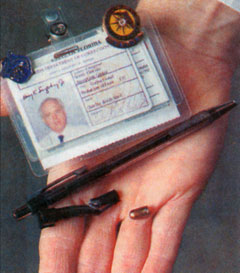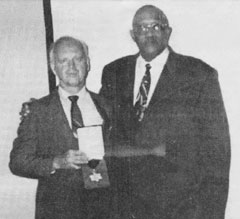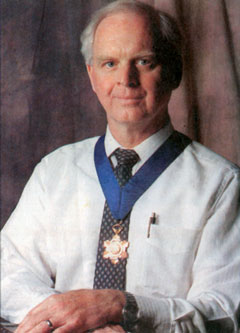1996
OFFENDER POPULATION JUNE 30, 1996:
INMATES:64,333
SUPERVISED:137,611
INMATES:64,333
SUPERVISED:137,611
Desoto Correctional Institution Annex(Arcadia, FL), Santa Rosa Correctional Institution (Milton, FL) and Dade North Annex (Florida City, FL) open.
The Legislature moves the Justice Data Center to the Department of Corrections. Over the last 16 years, the department has gradually become the primary user of the data center. To fully implement this change, the data center (including the mainframe computer, network connections, climate control, etc.) must be moved.
The Legislature creates the Office of Certification and Monitoring of Batterers' Intervention Programs within the Department's Probation and Parole Services. The office is authorized to review and approve applications from batterers' intervention programs throughout the state in an effort to standardize programs.
 First web site is launched in February. It is hosted on the Department of State's server and consists of slightly more than a dozen web pages. Later in the year the 100+ page, 1994-1995 Annual Report becomes the first publication placed on the Department's web site. Internet connectivity is established for the agency (replacing dial-up access) and staff begin to receive Internet access from their workstations
First web site is launched in February. It is hosted on the Department of State's server and consists of slightly more than a dozen web pages. Later in the year the 100+ page, 1994-1995 Annual Report becomes the first publication placed on the Department's web site. Internet connectivity is established for the agency (replacing dial-up access) and staff begin to receive Internet access from their workstations
 Click here to listen to Secretary Harry K. Singletary discuss how the Department's website was born.
Click here to listen to Secretary Harry K. Singletary discuss how the Department's website was born.
On July 1, 1996 the Department, in conjunction with the National Institute of Justice, develops a risk classification model which predicts the likelihood offenders will reoffend, technically revoke, or abscond during their terms of supervision. Based on the results of this pilot program, the department continues the project and expands to a larger judicial circuit by the end of 1996.
Legislature approves the Department's plan to reorganize. This process joins community correctional centers (work release) with probation and parole, under the umbrella of the Office of Community Corrections.
Correctional Probation Officers collect $21.8 million in cost of supervision fees from offenders on community supervision, $23.3 million in victim restitution and $10.6 million in court fines and costs.
The collection of subsistence payments at probation and restitution centers is automated through the Court Ordered Payment System.
A new sentencing guidelines scoresheet and related procedures are published and data entry audit procedures are established for sentencing guidelines score sheets.
4,000 Correctional Probation Officers and staff supervise over 135,000 offenders. Correctional Probation Officers also conduct more than 250,000 investigations, including pre- and post-sentence investigations. Payments collected during FY 1995-1996 total $55,874,231.
COMPUTERS
![]() Each day the Offender Based Information System (OBIS) mainframe computer processes over 900,000 transactions (that's how often an ENTER key is hit), and 2,500 batch reports that print around the clock. Programming staff maintains over 200 online screens and over 800 batch programs that are constantly in use by over 15,000 users.
Each day the Offender Based Information System (OBIS) mainframe computer processes over 900,000 transactions (that's how often an ENTER key is hit), and 2,500 batch reports that print around the clock. Programming staff maintains over 200 online screens and over 800 batch programs that are constantly in use by over 15,000 users.
There are approximately 4,000 personal computers (PCs) scattered around the state with software ranging from spreadsheets and e-mail to word processing and simple database management.
There are over 120 minicomputers (DEC/VAX and Data General) at the major institutions, regional offices and P&P offices responsible for things like the cashless canteen, reception center processing, inmate badging, inmate bank and others.
The department has 12 locations throughout the state that have their own LANs (Local Area Networks) making the department the leader in that area in state government.
The average percentage of sentence served by inmates released as of June 30 is 65.3%.
LEVY COUNTY QUILT MUSEUM
May 1996 – Inmates from Lancaster C.I. begin construction of the Levy County Quilt Museum. The assistance of these inmates is detailed in "The History of the Levy County Quilt Museum and the Log Cabin Quilters." In it, they say "The club could not afford to employ workers with their small budget and (volunteer) Bob Busch was not a one-man show. He couldn’t build it himself. And once again, assistance came from an unexpected source – Lancaster Correctional Institution. When asked for help, Lancaster quickly agreed to supply a work squad. And the prisoners did well. One young inmate said he had never worked construction before. He said Busch had taught the inmates a lot of construction techniques and has been patient with them. He went on to say it is a lot better than mowing. At the Museum building site, he is learning something he can put to good use when he gets out. 'When they came out here,' said Lt. B.A. Simmons, the head of the work camp program for Lancaster, 'I didn’t know if any of them could drive a nail or drive it straight. They have learned a lot.' The knowledge gained by the inmates from working as a construction crew is in all our best interests."
PROBATION OFFICER SHOT FIVE TIMES BY PROBATIONER,
RETURNS FIRE AND SURVIVES
On March 16, 1996, Correctional Probation Officer Keith Ward became the first Florida state probation officer to return fire in the line of duty. He was shot five times by probationer Sylvester Lloyd, Jr., in the chest, head, forearm, hand and shoulder. The shooting took place in Macclenny, near Gainesville, when Ward was checking on Lloyd’s whereabouts during a routine residence visit. Lloyd shot Ward without provocation while he was driving away from Lloyd’s residence.
According to Ward, when the first shot was fired, “I rolled about 20 to 30 feet with him prancing alongside my pickup truck, taunting, after the chest and head shots. I figured I was dead. It got my survival juices going and lunged out the window at him and grabbed his gun. I believe that’s when I received the hit that tunneled the length of my forearm and the shoulder hit. Then I crashed into a tree.” At that point he drew his approved firearm and hit his attacker with three of his four shots. He said he never lost consciousness and was trying to dial 911 when help arrived. “The EMTs kept reassuring me that my lungs weren’t gurgling and my heart was okay.” Incredibly, he was released from the hospital hours later.
At that time, probation officers were not routinely issued bulletproof vests, though they could request them. One of the shots that hit him in the chest (he has entrance and exit wounds in his chest) shattered the Pilot pen in his shirt pocket and may have deflected the bullet enough to save his life. The Pilot pen company gave Ward a dozen replacement pens when they heard about his narrow escape. Ward still has the shattered pen, and the bullet it deflected.

Correctional Probation Keith Ward's life was saved by a Pilot pen he carried in his shirt next to his heart. (Photo courtesy of The Gainesville Sun, Feb. 16, 1998)
The offender, Lloyd, received a 20-year sentence for attempted second degree murder and was released on October 3, 2013. He was not given probation upon his release.
“This entire episode has intensified my desire to be what I should be,” said Ward in a January 1999 Gainesville Sun article about this incident. “We all have a picture of what we think we are, but that is not necessarily what we really are. I think being shot helped me get these two images closer together.” He later added, “But I still have a long way to go!”
Ward received the Medal of Valor from the Department for his actions.

Correctional Probation Officer Keith Ward receiving DOC Medal of Valor from Secretary of the Department of Corrections Singletary at awards ceremony Oct. 15, 1997. (Photo courtesy of Union County Times, Jan. 1, 1998)

Correctional Probation Officer Keith Ward wears the DOC Medal of Valor. (Photo courtesy of The Gainesville Sun, Feb. 16, 1998)
- 1821-1845
- 1868-1876
- 1877-1895
- 1900-1919
- 1921
- 1922-1924
- 1927
- 1928-1931
- 1932 | CHAPMAN
- 1933-1935
- 1936-1939
- 1940-1945
- 1946-1949
- 1950-1955
- 1956-1961
- 1962 | WAINWRIGHT
- 1963-1965
- 1966-1969
- 1970-1975
- 1976-1979
- 1980-1986
- 1987 | DUGGER
- 1988-1990
- 1991 | SINGLETARY
- 1992-1995
- 1996-1998
- 1999 | MOORE
- 2000-2002
- 2003 | CROSBY
- 2004-2005
- 2006 | MCDONOUGH
- 2007
- 2008 | MCNEIL
- 2009-2010
- 2011 | BUSS
- 2011 | TUCKER
- 2012 | CREWS
- 2013-2014
- 2014 | JONES
- 2015-2018
- 2019 | INCH
- 2020-2021
- 2021 | DIXON
- 2022-Today
- Population Summary Table

